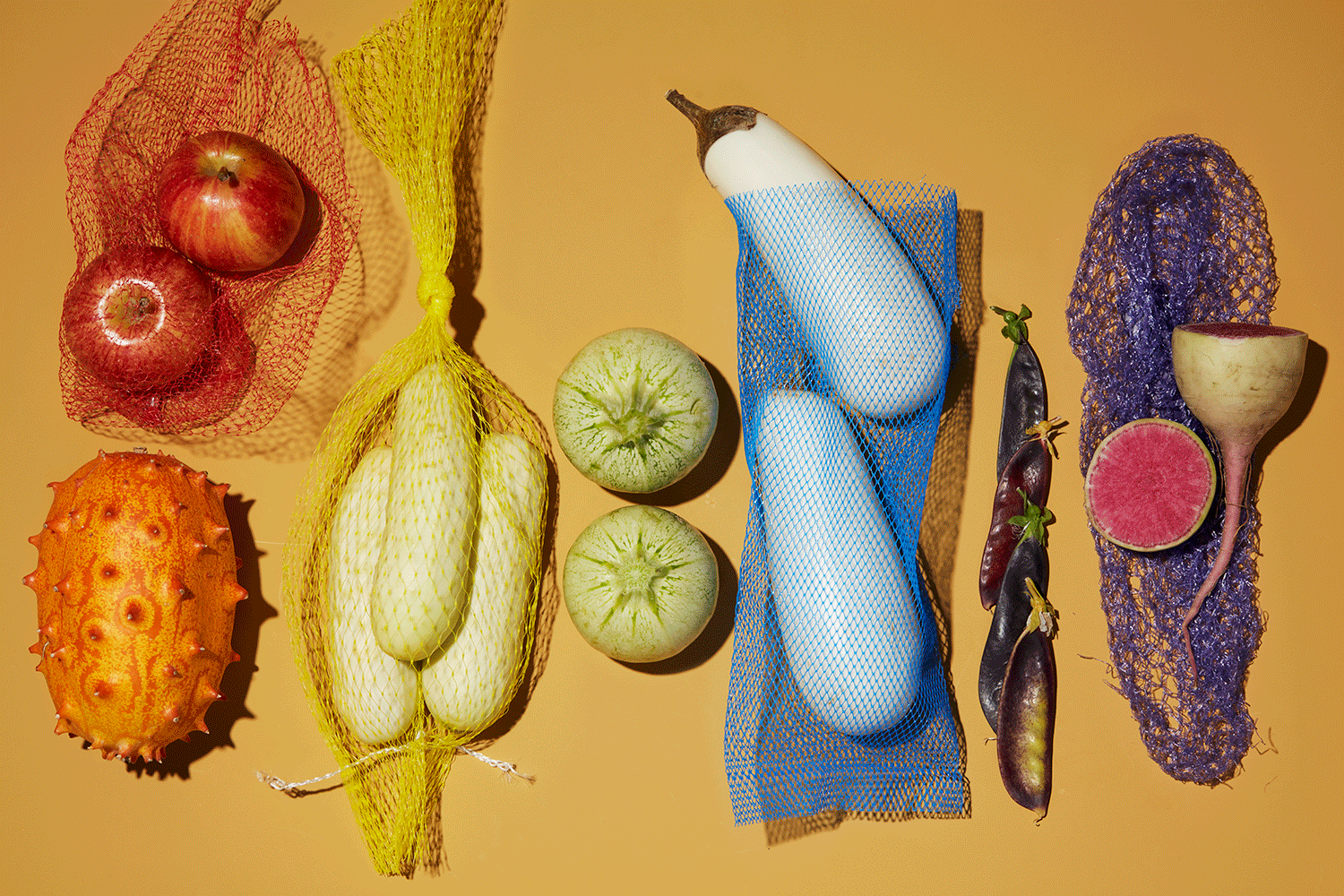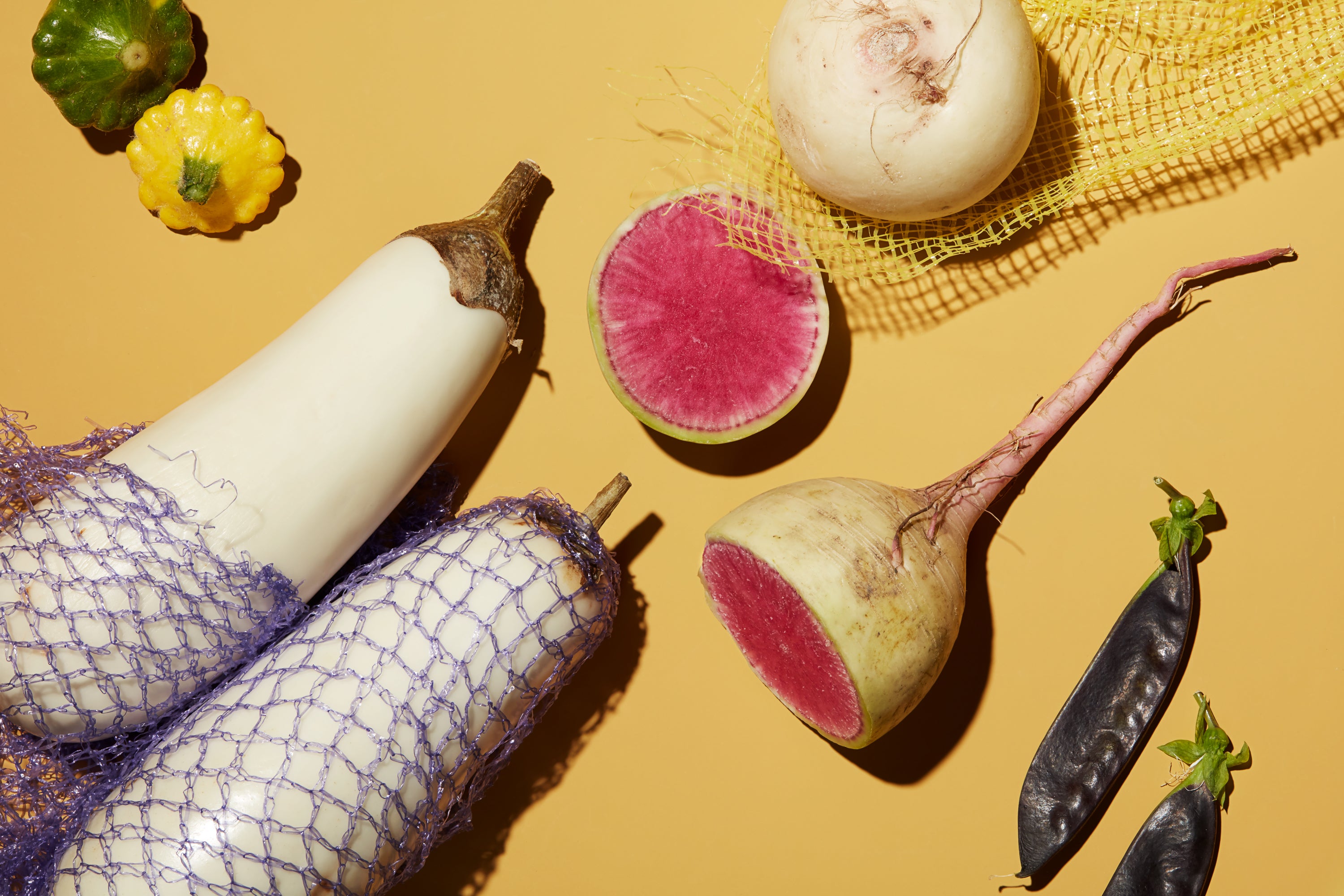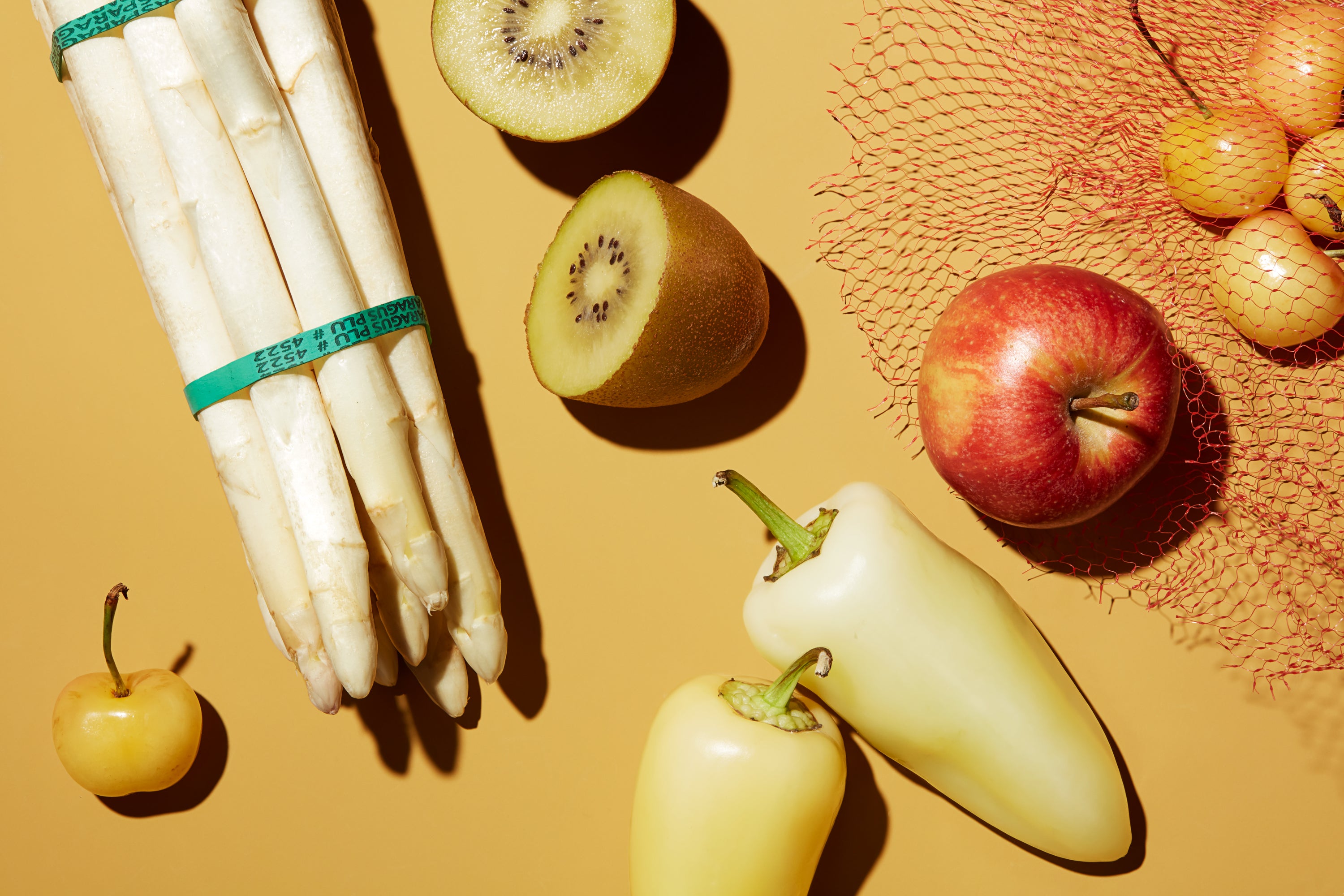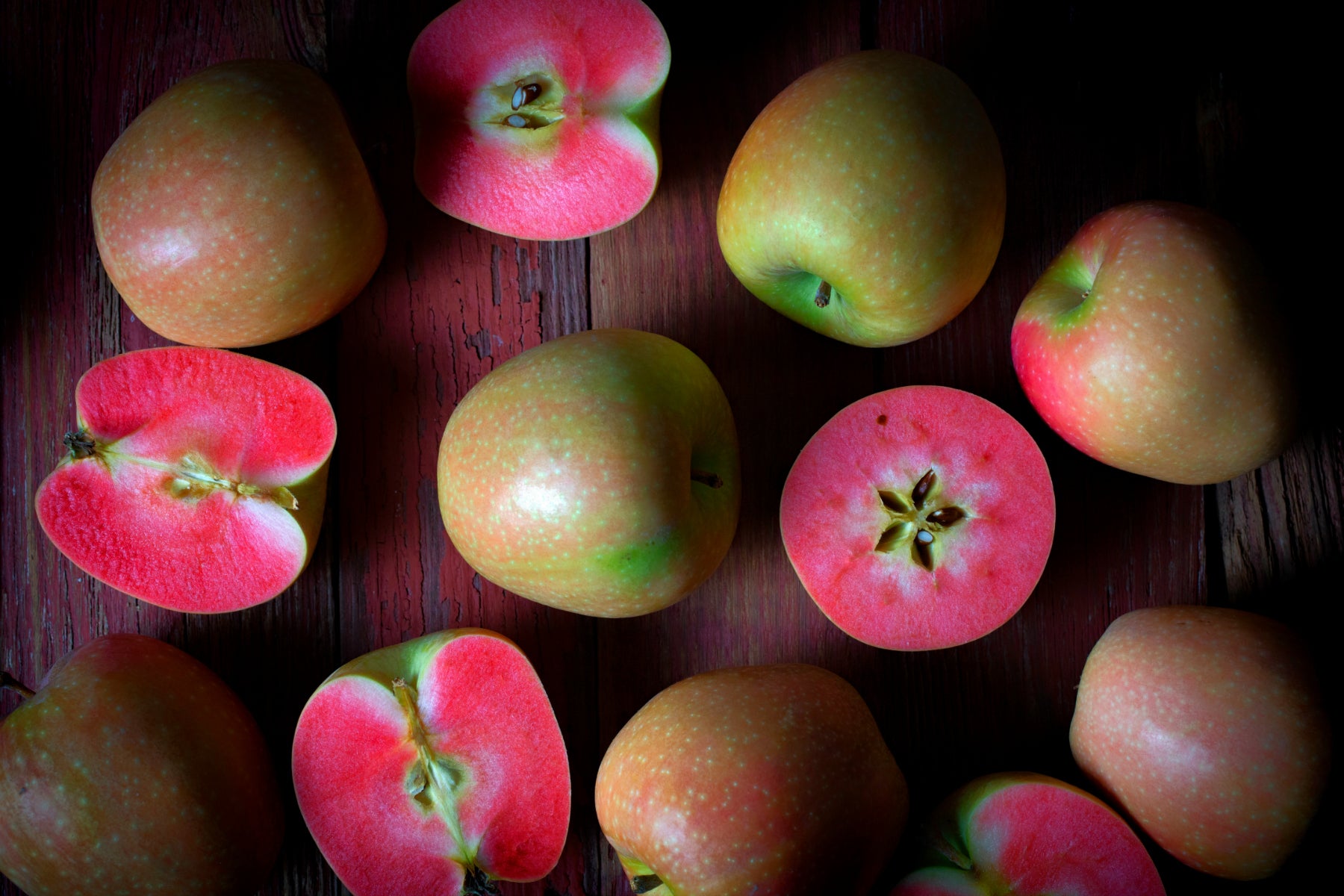
A decade ago, many consumers rejected unusual-looking fruits and vegetables. Now, thanks to social media, they can’t get enough of them.
Every fall, Brady Jacobson’s phone begins to ring more than usual. People call her from all over the country asking her the same question: Is the Mountain Rose apple available yet?
Since 1981, Johnson and her husband, John, have owned and operated Mount Hood Organic Farms, a 200-acre spread located at the base of Oregon’s Mount Hood. They’ve been growing Mountain Rose apples since 1989.
The Mountain Rose is a freakish little marvel of produce: Its flesh is starburst pink, and it’s the rare cooking apple that retains its color if you bake it into a pie at 400 degrees. And then there’s its taste: tangy and tart, like a strawberry Jolly Rancher. Jacobson picks the apples in the third week of October, just before their interior gets too mealy. Once winter hits, the season is over.
The Mountain Rose belongs to a growing, disjointed family of visually novel produce that tends to saturate Instagram feeds; it’s the stuff of the explainer posts posts that have become the grist of digital food media.
Not too long ago, this class of produce could be a marketing department’s greatest nightmare.
There’s the fairytale eggplant, tinier than the size of an adult palm, its violet exterior marbled with skid marks. Lanky witch-finger grapes. The lunchbox sweet snacking pepper, Lilliputian, like something Thumbelina might eat. White strawberries with skin the color of Boston Cream custard. Finger limes with guts that spill out of them like tiny toy jewels. Watermelon radishes with bloodstained interiors. White asparagus stalks the size of baseball bats.
Not too long ago, this class of produce could be a marketing department’s greatest nightmare. It was produce that consumers found unappetizing based purely on appearance, the kind that taste buds preemptively rejected because the human eye could not recognize it as familiar. A grape shaped like a teardrop was once considered one of the earth’s many ugly stepchildren.
But the ubiquity of odd produce on social media has thrust it from the peripheries of America’s gastronomic information to its forefront. Conversations surrounding what Instagram is doing to our eating habits often get couched in the language of concern, but social media platforms can also serve as the first touchpoint for consumers who might not know such an aesthetic wonder as a pink apple exists—and, as such, can be a marketing department’s dream come true.

That’s certainly the case with the Mountain Rose. When Melissa’s Produce, a California-based supplier, first carried the apple about eight years ago, it had about 40 cases. Now, according a company spokesman, it has 5,000, and a large part of that growing demand is thanks to Instagram. Social media has also been behind the ascendence of the pimply-fingered Buddha’s Hand Citron; although the California-based grower Ripe to You has been harvesting it for nearly two decades, demand for the fruit has spiked in recent years. “Awareness plays a big part in that,” says Ripe to You’s cofounder Eric Christensen.
Some erstwhile pariahs of the produce aisle are even making their way into meal kits: Blue Apron stuffs its boxes with variegated pink lemons, their rinds striped green and gold, their flesh blush in color. When the company first introduced pink lemons to its boxes in February 2017, it explained in a blog post that its goal was to help “create demand for an array of delicious yet under-the-radar produce that might otherwise be overlooked.” John Adler, Blue Apron’s culinary director, echoes this when he tells me that the pink lemon’s inclusion in meal kits grew out of a sense of “responsibility” Blue Apron has to create moments of “surprise and delight” in the kitchen.
Adler has used the pink lemon in at least 20 recipes, incorporating it into everything from a brown-butter pan sauce to ricotta. Its flavor is similar enough to that of most mass-market lemons, Adler says, to act as a bridge to home cooks who may not otherwise be compelled to try the pink lemon if they see it on FreshDirect.
“To find that it doesn’t have too foreign a flavor is a benefit,” Adler tells me. “We’re showing home cooks a new ingredient and asking them to use it in a familiar way. There’s only so much risk, so to speak, you can ask someone to take with their weeknight dinner.”
The pink lemon may taste a lot like a Eureka lemon. But the Mountain Rose apple doesn’t taste anything like a Gala or Honeycrisp, thus inverting what most Americans may expect an apple to be in both appearance and taste. The Mountain Rose goes by different names; some farms, Jacobson tells me, call it Airlie’s Red Flesh, honoring its birthplace in Airlie, Oregon. Others refer to it as the Hidden Rose.
Whatever you call it, the Mountain Rose apple may provide the most compelling case study for the growing popularity of the kind of aesthetically unique produce that was once written off as being grotesque in appearance.
After seeing the early success of the Mountain Rose with her farm-stand customers, Jacobson decided to plant more trees, trading scionwood with Randy Kiyokawa, a farmer whose Kiyokawa Family Orchards is also in the upper Hood River Valley. Kiyokawa has been harvesting the Mountain Rose apple since 2001. “I first planted it for the novelty’s sake,” he tells me. “I didn’t know how the consumer would like it at first, but I’d see the reaction and realized people really liked it.”
Both Jacobson and Kiyokawa stress that growing the Mountain Rose apple isn’t easy, a reality that impedes the possibility of mass production. I ask Jacobson if she foresees a hypothetical apocalyptic scenario in which the demand outpaces the supply, putting a strain on farmers like her. “It’s not a grower-friendly apple. It drops its fruit,” she tells me. “It probably will be never grown on any commercial scale because of this.”
The challenges of growing the Mountain Rose haven’t done anything to stymie demand for it. Two years ago, Francois de Melogue, a sales executive for the Washington State–based produce supplier and distributor Foods in Season, bought 1,000 pounds of the apples from Mount Hood Organic Farms. Last year, the company, which sells to 5,000 chefs nationwide, bought 6,000 pounds.
For a long time, if you were a chef in a French restaurant, you’d do duck a l’orange, French onion soup, very cliché stuff. Now, you’re not locked into a dogma of people in my generation. Pink apples are no longer taboo.
“The Mountain Rose apple was the thing everyone talked about, but you couldn’t get it for at least 10 years,” says de Melogue, who has watched the apple’s explosion in popularity with bemused interest. “It was this mythological thing.” Foods in Season now supplies 10-pound boxes of Mountain Rose to 500 chefs across the country. “They want more,” de Melogue says. “We have chefs pissed off when we run out.”
When I ask if he thinks Instagram has anything to do with this demand, de Melogue asks me if I’m kidding. “As a chef of a restaurant for 30 years, I’ve seen a lot of trends come and go,” he says. “In those old days, you hired a PR company, and they’d send out press releases.” Instagram changed the game. “Now, as soon as one guy sees it, everybody and their grandmother needs it,” de Melogue says. “Our phones are off the hook.”
He reminds me to consider the Mountain Rose apple’s humble beginnings as a descendant of a red-fleshed apple in Siberia. That apple landed on our shores in 1840, when German immigrants planted it in the Ohio Valley. It was once called the Surprise, the implication being that eating it induced semi-unpleasant shock. The Fruit and Fruit Trees of America, a guidebook published in 1890, dismissed the Surprise as “small, round, whitish yellow apple of little or no value, but admired by some for its singularity, the flesh being stained with red.”
“In America, we weren’t about diversity until recent history, as much as we want to pretend,” de Melogue says, laughing. “Any apple that was red-fleshed was considered weird, a novelty.”
Over the three decades de Melogue spent in kitchens, he noticed standards begin to shift, with chefs enjoying new leeway to play with produce that may have once been considered off-limits. “For a long time, if you were a chef in a French restaurant, you’d do duck a l’orange, French onion soup, very cliché stuff,” de Melogue says. “Now, you’re not locked into a dogma of people in my generation. Pink apples are no longer taboo.”
De Melogue’s done everything he can think of with the Mountain Rose. He sometimes opts for simplicity, putting it in galettes to better appreciate the purity of its flavor. Or he’ll dip the apples in calvados-fortified beignet batter and fry them. He’s found that the Mountain Rose’s beauty can shine outside of the realm of sweets, too, as it does when the apple is steamed with mussels.
De Melogue points me to Foods in Season clients like Anthony Demuro of Phoenix’s Different Pointe of View. Demuro has been using the apple for at least two years, mostly because of its appearance but also because of its malleability; he’s made everything from vinaigrettes to purees from hot sauces with it. In Washington, D.C., chef Bin Liu has worked the apple onto the menu at Pineapple and Pearls by simply shaving it raw as part of a carpaccio of white sturgeon with white beets.
Chef Michael Langdon became aware of the Mountain Rose in 2015, when his Clarks Summit, Pennsylvania, restaurant, Alter House, started buying it from Foods in Season. Langdon didn’t know the apple even existed before that.
“I’ve [done] takes on tarte tatins on them to showcase their color, because it’s so unique,” he says. “I’ve diced and served them with foie gras to cut through its richness.”
Langdon tells me he’s noticed a trend over the past few years: If people see a photograph of the Mountain Rose apple on Instagram, they’ll be inclined to investigate his restaurant, meaning it may get more foot traffic from a photo on social media than more traditional marketing tactics. People don’t want to read anything; they want to see pictures.
It’s a common thread running through my conversations with growers and suppliers of produce beyond the Mountain Rose. When I ask what has changed the nature of their job in recent years, most everyone along this supply chain names the same culprit: Instagram. It’s the intermediary that has shepherded the pink lemon and Buddha’s hand citron to the Mountain Rose’s level of prominence, a coveted object of appeal that was once deemed too hideous for consumption. Instagram provides its own kind of education, and Langdon likes it that way. Instagram gets patrons in the door.
And the Mountain Rose keeps them there. “The flavor is incredible,” Langdon says. “And they don’t look like any other apple you’ll ever see.”

